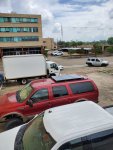I am new to fcc licensed radios and my spouse will barely use one, much less study for an amateur or ham license. So I got a gmrs license and some 5w (I thiygt, they are actually 2w) handhelds. We are often on our 75 wooded acres in the middle of a cellular hole. The rest of the time we are at our city place. Obviously, those handhelds offer great simplicity to encourage her, and they have FM radio so there's that, but the range is not great through the trees.
I'm getting up to speed quick and have learned how to access open repeaters. Time for higher wattage mobile radios (50w).
Vehicle 1 is a lifted Excursion. Ten feet of metal on top. I already have an NMO cell booster antenna ********** in the center of the usable space above the roof console/done light. 2 feet behind that is about 5.5 feet of solar panels that sit 3 inches above the roof and have aluminum frames. I'd be glad to explain why I have solar panels but that exceeds the scope of this part of the forum. Solar panels are on a non standard, DIY rack with crossbars constructed of utilistrut. There are no rails in the sides. I was concentrating on making it hard to see what they are and keeping them safe from theft before I contemplated mobile radios. Rack is attached to smittybilt mounts that fit in the Ford roof rack track. I've read all that I can but I am just dumb about antennas at the moment. Presumably, putting a dual band (FRS/GMRS) antenna at 50w next to my cell booster antenna is a dumb idea. Also, presumably putting a bracket on a solar panel frame above the roof, or an nmo mount next to a solar panel, is a dumb idea. So what I am left with is hanging an angle bracket off of a smittybilt mount, an nmo at the back of the truck, or a lip mount somewhere. I'm a little shy about the 50w right in my face, so maybe a lip mount on the rear hatch???
Vehicle 2 is a true billy goat, but with a fiberglass roof and a sun roof. And a moon roof for that matter.
Vehicle 3 is even more of a billy goat, but has a lot more electronics than the others, and has three glass roofs!
Can someone guide me in how to mount antennas that won't cook my brain, ruin the swr, cook the radios, or otherwise make me look like a dummy to my already skeptical spouse?
I should have mentioned, our driveway is an adventure. Half mile requiring constant maintenence, on a hill, with trees barely missing my 7.5 foot tall Exursion (and usually missing my approximately, additional 12 inch tall cell booster antenna). Tall, high gain antennas are out of the question. I have no problems drilling holes in my roofs and have the nerves of steel and appropriate equipment to do so.
Thanks for reading.
I'm getting up to speed quick and have learned how to access open repeaters. Time for higher wattage mobile radios (50w).
Vehicle 1 is a lifted Excursion. Ten feet of metal on top. I already have an NMO cell booster antenna ********** in the center of the usable space above the roof console/done light. 2 feet behind that is about 5.5 feet of solar panels that sit 3 inches above the roof and have aluminum frames. I'd be glad to explain why I have solar panels but that exceeds the scope of this part of the forum. Solar panels are on a non standard, DIY rack with crossbars constructed of utilistrut. There are no rails in the sides. I was concentrating on making it hard to see what they are and keeping them safe from theft before I contemplated mobile radios. Rack is attached to smittybilt mounts that fit in the Ford roof rack track. I've read all that I can but I am just dumb about antennas at the moment. Presumably, putting a dual band (FRS/GMRS) antenna at 50w next to my cell booster antenna is a dumb idea. Also, presumably putting a bracket on a solar panel frame above the roof, or an nmo mount next to a solar panel, is a dumb idea. So what I am left with is hanging an angle bracket off of a smittybilt mount, an nmo at the back of the truck, or a lip mount somewhere. I'm a little shy about the 50w right in my face, so maybe a lip mount on the rear hatch???
Vehicle 2 is a true billy goat, but with a fiberglass roof and a sun roof. And a moon roof for that matter.
Vehicle 3 is even more of a billy goat, but has a lot more electronics than the others, and has three glass roofs!
Can someone guide me in how to mount antennas that won't cook my brain, ruin the swr, cook the radios, or otherwise make me look like a dummy to my already skeptical spouse?
I should have mentioned, our driveway is an adventure. Half mile requiring constant maintenence, on a hill, with trees barely missing my 7.5 foot tall Exursion (and usually missing my approximately, additional 12 inch tall cell booster antenna). Tall, high gain antennas are out of the question. I have no problems drilling holes in my roofs and have the nerves of steel and appropriate equipment to do so.
Thanks for reading.
Last edited:


